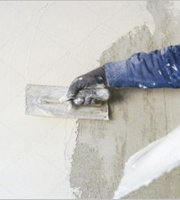Pipeline connection ● galvanized steel pipes must be connected with pipe hoop threads.
the construction procedures of plastic electrical exposed pipe laying are: construction preparation → determining the position of box, box and fixed point → support Hanger fabrication and installation → pipeline laying and connection → box fixing → deformation joint treatment E.
The threading shall not be disorderly buckled, the pipe orifice shall be filed smooth and flat, the pipe hoop must use the through wire pipe hoop, the joint shall be firm and tight, and the exposed wire shall not be more than 2 buckles; Matching pipe fittings and adhesives shall be used for plastic pipe connection.
selection of Conductor: the conductor of each circuit shall be selected in strict accordance with the model and specification of the design drawing.
When there is a ceiling for the upward lead pipe, the upper end of the pipe shall be simmered into a 90 ° bend into the ceiling.
30m without bending; 20m when there is a bend; 15m when there are two bends; When there are three bends, 8m.
Concealed pipe laying method: ● piping with wall (masonry): when building wall riser in cooperation with civil engineering, the outer protective layer of the pipe shall not be less than 15mm, and the pipe with the nozzle upward shall be sealed to prevent the pipe from being blocked by cement mortar or other sundries.
Pipeline cleaning: after piping, all pipelines must be cleaned before threading.
Deformation joint treatment: the piping passing through the deformation joint shall be equipped with compensation device.
The lead pipe from the top plate shall not be too long to reach the upper opening of the switch box.
Fixing method of supports and hangers: according to the structural characteristics of the project, the supports and hangers are mainly fixed by pipe expansion method (i.e.
The construction procedures of plastic electrical concealed pipe laying are: construction preparation → prefabrication and processing pipe bending → measuring the position of box and box → fixing box and box → pipeline connection → deformation joint treatment D.
2) Exposed pipe laying: A.
The yellow, green and red conductors shall be used as phase a, B and C wires respectively, the yellow and green two-color wires shall be used as grounding wires, and the blue wires shall be used as n wires.
When the threading line is blocked, two steel wires can be threaded into both ends of the pipeline respectively and stirred at the same time to hook and twist the ends of the two steel wires together, and then pull out the tape line.
c.
b.
(1) Construction process a.
Prefabrication and processing: ● when the diameter of galvanized steel pipe is 20mm and below, bend with bent rod; When the pipe diameter is 25mm and above, hydraulic simmer bender shall be used; The bending of plastic pipe shall be operated by supporting spring.
● if the pipeline exceeds the following lengths, a junction box shall be installed, and its position shall be convenient for threading.
Prefabrication and processing of pipe bending, support and hanger: the bending radius of exposed piping or piping in buried brick wall shall not be less than 6 times of the outer diameter of the pipe.
The mortar shall be full, flat and firm, and the position shall be correct.
● cast in situ concrete floor Piping: first determine the position of the box, pop up the cross line according to the thickness of the wall, fix the blocked box firmly, and then lay the pipe.
The purpose of pipeline cleaning is to remove dust, mud and other sundries in the pipeline..
Grounding connection: the galvanized steel pipe pipeline shall be integrally grounded.
Threading: the purpose of threading is to check whether the pipeline is unblocked and whether the direction of the pipeline and the quality of boxes and boxes meet the requirements of design and construction drawings.
The distance between the fixed points shall be uniform, and the distance between the pipe clamp and the terminal, turning midpoint, electrical appliances or junction box edge shall be 150 ~ 300mm, which shall be consistent; The maximum distance between pipe clamps in the middle is shown in the table below: list of the maximum distance between pipe clamps in the middle of open piping name pipe diameter (mm) 15 ~ 2025 ~ 3232 ~ 4050 ~ 6565 the maximum distance between pipe clamps (mm) wall thickness > 2mm steel pipe 15002000250025003500 wall thickness ≤ 2mm steel pipe 100015002000 / / hard plastic pipe 100015002000 d.
After the partition wall is built, fix the box first and then connect the short pipe.
After the pipeline is prepared, the concrete pouring construction shall be completed simultaneously with the civil engineering.
A margin of 10 ~ 15cm shall be reserved at both ends of the pipeline (when the pipeline is long or has many turns, the belt wire can be threaded together while laying the pipeline).
Measuring the position of boxes and boxes: determine the axis position of boxes and boxes according to the design requirements, take the horizontal line popped by civil engineering as the benchmark, hang the line for alignment, and mark the actual size and position of boxes and boxes.
see the construction method of concealed pipe laying where the exposed pipe laying process is the same as the concealed pipe laying process.
The bending radius of piping embedded in concrete shall not be less than 10 times of the outer diameter of the pipe.
● connection of pipe into box and box: the opening of box and box shall be neat and consistent with the pipe diameter.
The size of the pipe to be cut shall be measured, and it shall be firmly clamped in the jaw for cutting.
The length of more than two pipes entering the box and box shall be the same, the spacing shall be uniform and arranged neatly; After the plastic pipe enters the box and box, it shall be fixed with a lock.
● pipe cutting: steel pipe shall be cut with hacksaw, pipe cutter and grinding wheel saw.
The plastic pipe shall be operated by supporting pipe cutter.
Although the specifications of supports and hangers are not clearly specified in the design drawing, they shall not be less than the following specifications: flat iron support 30 × 3mm; Angle steel support 25 × twenty-five × 3mm。 c.
The phase line, zero line and protective ground wire shall be distinguished.
The cutting fracture shall be flush without skew, the pipe orifice shall be scraped and filed smoothly without burr, and the iron filings in the pipe shall be removed.
● steel pipe threading: the steel pipe threading adopts threading plate, and the corresponding die shall be selected according to the outer diameter of the pipe.
drilling holes on the concrete roof and fixing with expansion bolts) and hoop method (i.e.
When the steel pipe enters the box and box, the pipe orifice shall be locked with a nut, exposing 2 ~ 3 threads of the locking nut.
the construction procedure of open pipe laying is: construction preparation → prefabrication and processing of pipe bending, support and hanger → determination of box, box and fixed point position → support Hanger fixing → box fixing → pipeline laying and connection → deformation joint treatment → grounding treatment C.
Measuring the position of boxes, boxes and fixed points: first measure the correct position of boxes, boxes and outlet according to the construction drawings, then pull the vertical and horizontal direction of the pipeline out of the straight line according to the measured position, and determine the specific position of supports and hangers according to the specified spacing dimension requirements of fixed points.
The piping crossing the protection unit must be sealed, and the corresponding methods shall be adopted for the sealing treatment according to their respective conditions.
The opening on box and box shall be opened with a hole opener to ensure that the opening is free of burr.
It is required that one hole for one pipe and no long hole shall be opened.
fixing the supports and hangers with hoops when encountering steel structure beams and columns).
b.
e.
the basic requirements for concealed pipe laying are: the wire pipeline, pipe orifice and pipe connection laid in dusty and humid places shall be sealed; Wires and pipelines shall be laid along the nearest route and bending shall be minimized.
b.
the construction procedure of concealed pipe laying is: construction preparation → prefabrication and processing of pipe bending → determination of box position → fixing of box and box → pipeline connection → deformation joint treatment → grounding treatment B.
f.
Strip line φ For 2mm steel wire, first bend one end of the steel wire into an unsealed circle, and then use the threading device to thread the belt wire into the pipeline.
e.
The length of the pipe entering the box shall be appropriate, and the pipe shall be tied with lead wire every 1m or so.
During threading, the force shall be applied evenly.
f.
Fixing box and box: stabilize the box and box first, and then grout.
g.
The supporting grounding card shall be applied at both ends of the joint, and 4mm2 double color copper core insulated wire shall be used as jumper wire.
Cast in situ concrete slab wall fixing box and box are fixed with supporting iron; For the cast-in-situ concrete floor, the box shall be blocked and fixed firmly with the bottom plate reinforcement.
When there are more than two boxes, draw a straight line.
threading construction procedure in pipe: construction preparation → selection of conductor → threading of stay wire → cleaning of pipeline → setting out and disconnection → binding of conductor and strip line → protective mouth → conductor connection → conductor welding → conductor binding → line inspection and insulation shake test (2) Main construction methods and technical measures 1) concealed pipe laying a.
c.
4) Threading in the pipe A.
It is forbidden to open holes in iron boxes and boxes by electric welding or gas welding,.
When passing through the deformation joint of the building, the grounding wire shall be provided with compensation device.
3) Civil air defense piping threading construction the civil air defense construction in the basement shall be carried out in strict accordance with 97 hufang-562.
The clear distance from the surface of pipes buried in walls or concrete shall not be less than 15mm; Buried wires and pipelines shall not pass through the equipment foundation.
d.
After the laying of concealed pipes is completed, on the basis of passing the self inspection, the owner and the supervisor’s representative shall be notified in time for inspection and acceptance, and carefully and truthfully fill in the acceptance records of concealed works.


